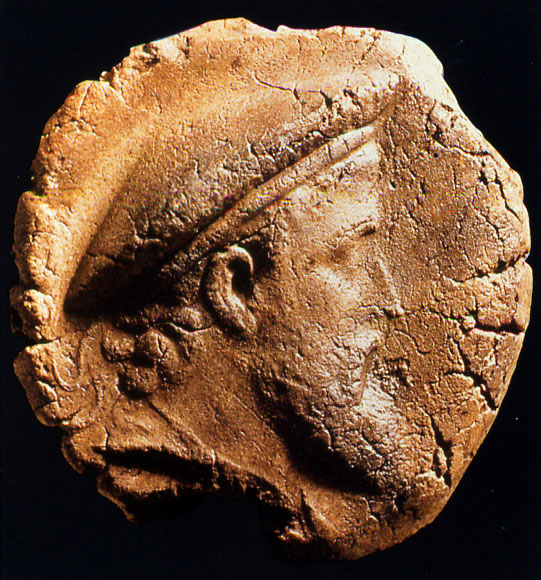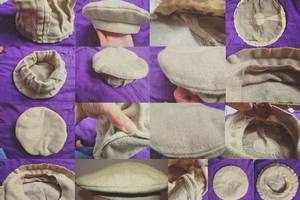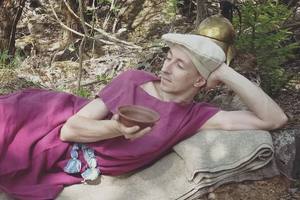Kaussia
Kaussia (Ancient Greek: καυσία) is a distinctive headgear worn by the peoples of the northern Balkan Peninsula. It existed in two similar but different forms in terms of construction and appearance.
The first variant resembles the well-known Afghan cap called "pakol" (also known as "pushinka," "afganka," or "pakistanka").
The other variant somewhat resembles the Georgian aerodrome cap, but instead of being flat, it is slightly conical.
Interestingly, in documentary photos from the 20th century, these caps resemble kausias even more than in the film "Mimino," where they are sometimes even conical. On the internet, you can read fascinating stories about the origin of Georgian caps from Sicilian "coppola sicilian" that arrived in the Caucasus with an Italian theater troupe, but I cannot judge how true it is. However, the resemblance to "pakols" is indeed close to 100%, except that they are now often made of fairly dense felt. Variants made of simple unshorn wool also suit us.
As for who borrowed the kausia from whom - whether the Afghans borrowed it from the Macedonians or vice versa - there are different opinions, but I think we can confidently speak about its Macedonian origin. Kausias are depicted on a fresco from the tomb of Philip II, who was buried even before the campaign began.
Kausias of the "Afghan" model can also be found in the frescoes of the Thracian Tomb. There are no such headgears on the reliefs of Persepolis, which depict subject peoples of the king of kings, among whom there should be Bactrians and Sogdians. During Alexander's campaign, many Macedonians settled in the territory of modern Afghanistan. On the one hand, they could not continue the campaign due to wounds and fatigue, but on the other hand, they had to become the backbone of the empire in this restless place.
In the Hellenistic period, based on some frescoes, statues, and coins of the Greco-Bactrian Kingdom, another variant of the kausia is well known. It can be provisionally called "Bactrian" since it is regularly depicted on coins of the Greco-Bactrian Kingdom. Moreover, it shows kings, like before, with Alexander wearing his lion helmet, which speaks to the prestige of such headgear.
 Coin with Demetrius II Seleucid in Kaussia. 2nd century BC
Coin with Demetrius II Seleucid in Kaussia. 2nd century BC
There are, at least in the early Hellenistic period, depictions of the "Afghan" model.
On all the images I know of, except for two, the kausia is white, beige, or cream-colored - in other words, white, as the fabrics of that time did not have an ideal snowy white color, and all these faint shades were most likely considered white. On one of the Pompeian frescoes, the kausia is blue-gold, and on another (from a villa near Pompeii), it is pale purple. The latter fresco, believed to have been created in the 60s BC, is thought to have been copied from a Macedonian fresco from the 3rd century BC (the appearance of the kausia on it is indeed quite well represented). There are theories that it depicts the Diadochi Antigonus or even Macedonia itself allegorically. This certainly explains the color of the kausia, but there is no definitive evidence. It can also be considered that the Romans, copying from the Greeks, simply made up everything.
Now let's talk about the construction and sewing experience. The "Afghan" variant is a cylindrical shape without one lid. A rectangular piece is sewn to the circular piece along the perimeter and then rolled up into a roll. It is better to make it longer; otherwise, the roll will keep unraveling. Then the kausia is turned inside out, and small folds (about 0.5 cm) are sewn, which disappear near the lid. The folds face outward. The number of folds adjusts the kausia to the size of the head. It is better not to make too many folds; otherwise, it will bulge at the top. To add stiffness, an additional layer of the same fabric or linen can be sewn on the inside of the circular piece. Without this, the dome of the kausia will bend significantly to match the shape of the head. In principle, the ancient kausias were not as flat as modern "pakols" because the latter were not made of felt. However, I'm afraid that without the second layer, it will outline the top of the head too much. The Afghan variant is simple to sew, but because of the folds, it is not as quick as the "Bactrian" variant.
In the "Bactrian" variant, the dome is not flat but conical. To achieve this, a sector is cut out of the circular piece and sewn along the cut. A similar piece of linen is sewn to it for density. A wide disc is sewn to the circumference of the cone, with the outer diameter matching that of the conical upper piece and the inner diameter matching the perimeter of the head. On the inner side of the disc, a folded rectangular piece of small width is sewn along the entire perimeter. Sometimes, a ribbon with long trailing ends was passed through it, which can be seen in many depictions. It allowed the kausia to be tightened and better secured if it was too large, but mine fits just right.
In terms of practical qualities, the kausia is very interesting. Unfortunately, it does not provide the same splendid shade as the Greek hat "pilos" (πῖλος), although it does provide a little protection for the eyes from the sun.




